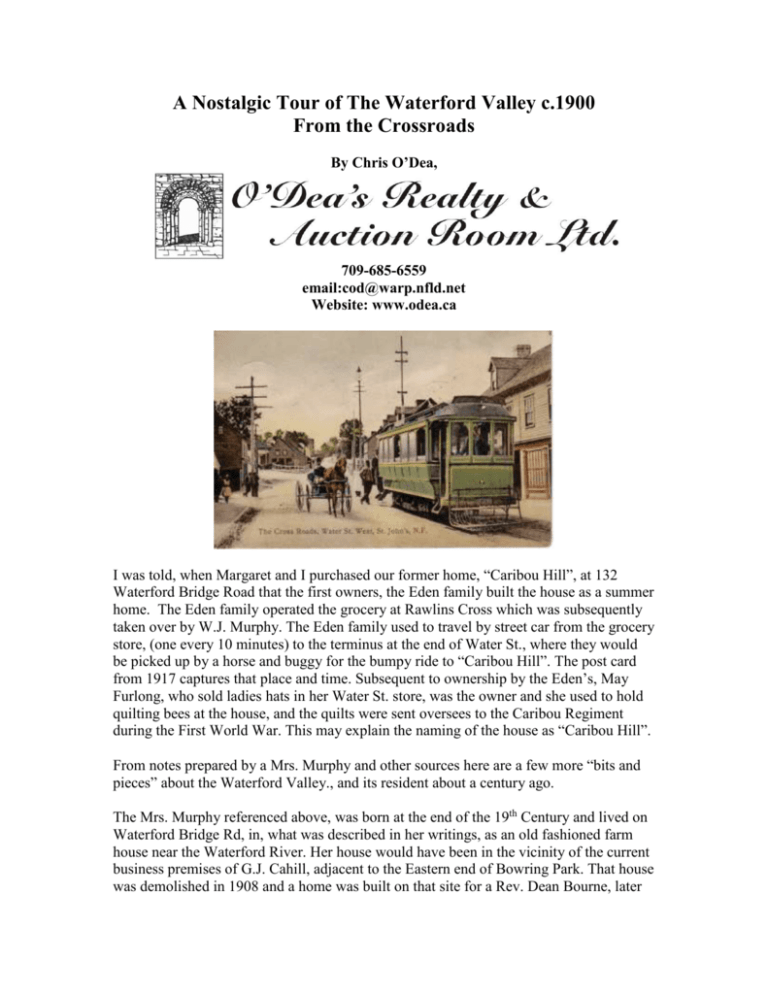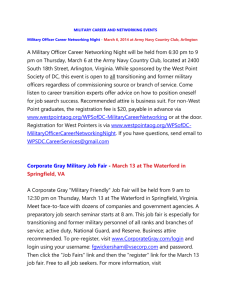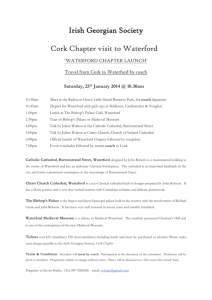A nostalgic tour of the Waterford Valley from the Crossroads c.1910
advertisement

A Nostalgic Tour of The Waterford Valley c.1900 From the Crossroads By Chris O’Dea, 709-685-6559 email:cod@warp.nfld.net Website: www.odea.ca I was told, when Margaret and I purchased our former home, “Caribou Hill”, at 132 Waterford Bridge Road that the first owners, the Eden family built the house as a summer home. The Eden family operated the grocery at Rawlins Cross which was subsequently taken over by W.J. Murphy. The Eden family used to travel by street car from the grocery store, (one every 10 minutes) to the terminus at the end of Water St., where they would be picked up by a horse and buggy for the bumpy ride to “Caribou Hill”. The post card from 1917 captures that place and time. Subsequent to ownership by the Eden’s, May Furlong, who sold ladies hats in her Water St. store, was the owner and she used to hold quilting bees at the house, and the quilts were sent oversees to the Caribou Regiment during the First World War. This may explain the naming of the house as “Caribou Hill”. From notes prepared by a Mrs. Murphy and other sources here are a few more “bits and pieces” about the Waterford Valley., and its resident about a century ago. The Mrs. Murphy referenced above, was born at the end of the 19th Century and lived on Waterford Bridge Rd, in, what was described in her writings, as an old fashioned farm house near the Waterford River. Her house would have been in the vicinity of the current business premises of G.J. Cahill, adjacent to the Eastern end of Bowring Park. That house was demolished in 1908 and a home was built on that site for a Rev. Dean Bourne, later occupied by the Thistle (Printers) family and subsequently the Newfoundland Rangers. There is a storyboard at the site today which references the site of the Newfoundland Rangers. It should be noted that Mrs. Murphy’s father was a master builder and built the chapel at Littledale The Knowling family, whose patriarch was George Knowling, a prominent St. John’s businessman, owned a “beautiful English type” house on the South Side of the Waterford River. Mrs. Murphy’s reference to the Knowlings means of transport warrants repeating as follows: “I can well remember the Knowlings being driven to business every day; the coachman in a blue melton coat, silver buttons and a high beaver hat with a silver band, and during the winter months a beautiful cutter sleigh with seats looking to front and Buffalo robes”. The Knowling house, which was occupied at a later time by the Outerbridges and then by the most recent owners, the O’Brien’s, was the house that was destroyed to make way for the new highway that connects the Trans Canada to the downtown. Please join me while we continue the tour. Neville’s operated a farm at what is now Bowring Park East of Littledale was the McNeil farm and greenhouses Opposite McNeil’s farm on the South side of Waterford Bridge was the property of a Captain Graham, which extended east to St. John’s lane. Their farm also occupied land on the North side of the river which also extended to St. John’s Lane. Next to Captain Graham was a Mrs. Bolt who made a living raising fowl and selling eggs. Adjoining McNeil’s and extending east, towards what is now Road DeLuxe, was owned by the Murphy family. William Stanley, in the employ of the McNeil’s, owned Jersey Cottage which was near and East of Road DeLuxe East Waterford Lane (formerly known of as St. John’s Lane and pronounced as Singens Lane) Mr. Andrew Delgado, from Seville, Spain, built what was called Waterford Hall. This is the property at 185 Waterford Bridge Road, now called Waterford Manor, which was designed by W.F. Butler. Mr. Delgado owned and operated Delgado’s Candy and Fruit Emporium on Water St. The Delgado building, which was built after the fire of 1892, still stands today. East of Waterford Hall was the R.H. Trapnell home, immediately opposite Road DeLuxe, later owned by Robert Murphy. He was referred to a “Telephone Bob” as he was the owner of the Avalon Telephone Co. That house was subsequently owned by J.B. Hand and was recently purchased by Fred and Doreen Cahill. The Cahills are to be commended for the outstanding restoration on that house and property. The Neville’s and the family of a John Murphy operated a farm opposite the Trapnell home, which extended to Topsail Rd. J.C. Rogerson had a large house next to the Neville property. On the South side, opposite the Rogerson House was Jersey Cottage (now demolished, possibly where Mary Pratt now lives), owned by William Stanley, who worked at the McNeil Farm. Adjoining Roberson’s, was a property owned by a Vivian family Adjoining Jersey Cottage was a riverside home own by Ellis Collishaw. At that time he was one of very few car owners in Newfoundland and was the agent for Vacuum Oil. The Collishaw home was later own by Thomas McNeil. Mr. Tom as he was known owned and operated the McMurdo Drug Stores until his death – he was drowned on the S.S. Florizel. Tom was a brother of Jack McNeil who operated the farm east of Littledale Returning to the North side of the road, adjoining the Rogerson property, was a square old fashioned cottage owned by a Vivian family. Adjoining the Vivian’s was a very large house on top of the Hill, then known as Reid’s Hill, and later as Caribou Hill. This house was owned by the Reid family, and later by the Goodridge family, after which it was sold to the Tessiers. Adjoining the Reid estate at the bottom of the hill was the Tessier family home and greenhouses. Adjoining Tessier was R. C. Reid. The gated entrance was built from two whale jaw bones, hence the name of the home “Whale Jaw Bones” Next to the Reid property is the General Protestant Cemetery. Across from the cemetery, if one were to look down at the approaching road to Syme’s Bridge, you would see a little saddle roof house which was owned by the grave digger. In fact the grave digger’s home was once facing Topsail Rd. on the North side of the Cemetery and in 1909 the house was towed by two horses down through the cemetery to its location at the base of Symes Bridge Returning to the South side of the road, adjacent to the Collishaw property, we would have seen the Rhodes property. This was described as a “cold looking high house with dormer windows. This house was at the bottom of Caribou Hill. The next house, on the same side as Waterford Bridge Rd, was high gabled roof house own by John Syme. He owned the farm land to the boundary of Symes Bridge. The Syme property still stands, and it is one of a small number of early homes on the street still standing in original condition. Just East of Syme’s Bridge, there was and still is a pedestrian shortcut on the steep incline of the hill. It was called Slippery Gap. Behind where the apartment building (built by Chester Dawe, recently converted to condos,) now stands, there was a tannery operated by a Canadian named McKean. The tannery, referred to as Thompson’s tannery, after the builder, was on an island that formed in the Waterford River basin, and was used for the tanning of seal skins. East of the tannery was occupied by Peter Walsh and then Bartholomew Walsh. Richard Shortall operated a farm east of Walsh’s. He also a cabman with a tenor voice and entertained his passengers with stories and songs. One of his more humorous titles to his songs was” I kissed her lips and left her behind for you”. Richard Shortall also owned a range of eight 1 ½ storey houses which were rented to tenants. The rent was said to have been $40 per year. Adjoining Shortall’s property was a large house owned by Charles Ayre of Ayre and Sons. John Ayre owned another large house to the east of Charles. This property was later purchased by aforementioned George Knowling and then sold to John Duff who operated the York Theatre on Water St. Adjacent to this property was a double house wich is still standing which was owned by the Anglican Church. The Western part was occupied by a Mr. Piles, who was a sleeping car conductor for the Reid Railway. East of that was a small confectionary store own by a Mrs. Reddy, on the corner of Mill Lane. On the East of Mill Lane stood a large old fashioned house occupied by Jim Kane who worked at Browning’s Bakery as a dough maker and property keeper. Next to Kane’s house was a row of tenement homes, one occupied by Police Sergeant Nugent. He was a fine gentleman and “quieted more riots and rows than the Queen’s Regiment” Around the corner and down the lane was the gateway to the Browning and Son Bakery, with the machinery driven by a water wheel located on the Waterford River. Browning’s had a large shelter, with an open front, built for the use of people waiting for the street car. It was quite large, had seats and was called “Rest Awhile”. It is interesting to note that Browning’s purchased the bakery from Robert Vail. He was the baker who developed and promoted the product that we know today as “hard tack”. Returning to the North side of the road, and east of the cemetery stood Tor Cottage own by Mr. Lauri or Lorenzo Moore. Tor Cottage, a hip roofed structure, would have been built c.1840, and was own by the Moore family until it was torn down about 15 years ago. Next East was the McDougall Meadow, which extended from Topsail Road to Waterford Bridge Rd. In later years it was own by Mr. Bert Cousins who built a very large home that was later purchase by Ches Pippy, and now operated as Compton House Heritage Inn. Next East was the Garret Byrne property, in the centre of which stood a large gabled house. Mr. Byrne owned two book stores on Water St. Mr. Byrne maximized the microclimate of the area and grew beautiful apples, strawberries and home vegetables. Next was a large meadow which extended to what was known as Big Lane, which is the small lane that crosses over from Waterford Bridge to Topsail Rd. A man named Reo, an engineer for the Reid Railway, erected a bungalow in the western end of the meadow, which was later occupied by an Edmund Kelly. East of Big Lane stood two mansard roofed houses. The occupants were named Clark. Then there was a very a very narrow crossover foot lane called Shortall’s Lane, where the home aforementioned Richard Shortall stood. Next East was an open space, however in later years, Patrick Shea erected a large house in 1904 named Westmount (designed by W.F. Butler) which was subsequently converted to apartments. This house still stands on that site. An interesting footnote to the Shea house relates to a suggestion for the name. Patrick Shea was at his regular card game at the BIS and mulling over names for his mansion. Waterford Hall was used. Victoria Hall was too common. He then asked his card playing friends if they had any suggestions? “Well Pat”, said Frank McNamara, “seeing you are in the liquor trade, why don’t you call it “Alco-Hall” We now come to the crossroads illustrated in the post card view illustrated at the beginning of this tour. In the “V” of Topsail and Waterford Bridge Rd, stood a quaint low wooden house and rum shop combined. The building, which is shown in the post card, was known as Torpy’s. In later years it was operated by a Mrs. Kelly. This building was the famous “John Brown’s Store” and John Brown’s daughter was referenced in a song by Ron Hynes. The sharp “V” `was the location of a post and longer fence, and every foot was usually occupied by horse and buggy, express car, long cart, and box cart. While the owners went in to Torpy’s for “one for the road”, the horses could be seen with nose oat bags in place. Even if the passengers had one too many for the road, the horse would still see them home safely. To the residents of the Waterford Valley or for that matter, anyone with an interest in the information contained in this document, I would welcome your corrections and additions. In the meantime, Chris O’Dea of O’Dea’s Realty and Auction Room would be pleased to assist you with all of your real estate needs. If you are buying or selling, you can be assured of exceptional service. If I can quote from a reference from Jane Urquhart: “It is a great pleasure to hunt for a house with Chris O’Dea. Not only is he a thorough and highly professional real estate agent, he also has a vast knowledge of heritage architecture and times gone by in Newfoundland. These qualities enable him to recount the history …. both structural and anecdotal…. of almost every dwelling in St. John’s. He is truly interested in getting to know his client, and this in turn facilitates an uncomplicated journey to the new home that best reflects that client’s personality, as well as the needs of his or her family… a marvelous experience.” For service consistent with the sentiments expressed by Jane Urquhart, whether it involves estate auctioneering or real estate, Chris O’Dea can be contacted at: Web site: www.odea.ca Email: cod@warp.nfld.net Cell phone: 685-6559






